+
![]()
(Also see magnetic antenna
version , op-amp version and
Compound Transistor version)
Also: Original Lightning Detector
Page
To observe the lightning strikes on a map in near real time
try:
https://www.iweathernet.com/lightning/latest-lightning-strikes-on-google-maps
The latency is usually under 10 seconds but that’s long enough
to make correlation with a flash from your detector with a flash on the map a
bit challenging.
![]()
Built to make the wiring easy to follow, but I prefer this
circuit to the original. Read the text below.
This new lightning detector circuit uses a single inductor tuned
circuit to receive static pulses from lightning at a frequency near 200 kHz. The
need for a tapped tuned circuit is eliminated by employing a very high input
impedance RF amplifier that uses a darlington transistor. The amplifier is
micro-power and the whole circuit draws only about 200 uA from two alkaline D
cells, hardly denting the shelf life. The flasher portion of the circuit is
similar to the earlier versions only the polarity of the transistors is
reversed. As a result the output pulses momentarily go to ground from a
normally-high state.
The schematic and close-up photos were made with the beginner in
mind. Questions about the schematic can be answered by close-up examination of
the photos. Try a magnifier utility for an even closer look.
The 150k resistor in the base of the 2N4401 may be
replaced with a series combination of a 100k resistor and a 100k (or greater)
potentiometer to add sensitivity control. Simply adjust the potentiometer until
flashing just stops for maximum sensitivity. The fixed resistor is plenty
sensitive for most users. But, the receiver will only work well outside or near
a window. A few yards of wire could be used to run an antenna out a window but
connect a 47 pF capacitor in series with the wire at the detector end. Also, connecting a good ground will improve the sensitivity. Keep the unit away from electronic or electrical appliances and
wiring for best performance.
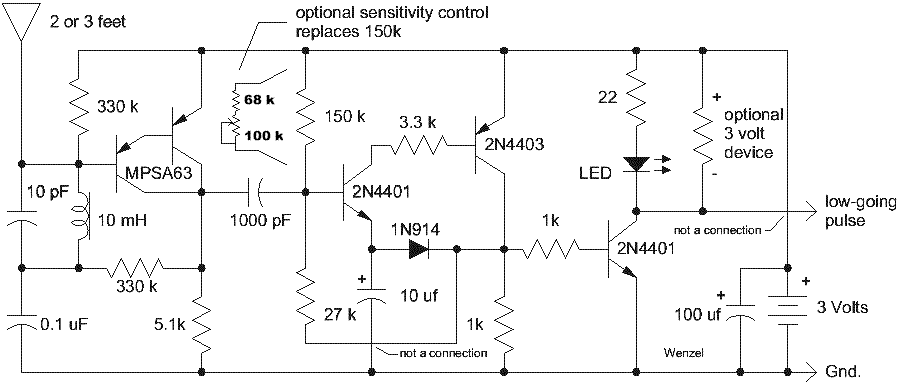
A common mistake is to select a 10 uH choke instead of a 10 mH.
The large green choke in the photo is typical of the size and markings to
expect. Color bands are brown, black, orange. A wide silver band often indicates
the beginning of the color code.
Some of the other parts in the prototype were chosen to make it
easy for the beginner to see the values. For example, the large .1 uF “orange
drop” can be a tiny ceramic type. Parts may be in odd positions, too. The orange 10 uF is twisted to make the markings visible and
other parts are oriented to make viewing easy.
The 100 uF shown across the battery is the blue part right below
the MPSA63 in the photo below. Notice how it isn’t right by the battery
connections. Sometimes the position of a component relative to others is
important but that information is often not on a schematic unless specifically
stated. Schematics aren’t usually physical representations; they just show which
legs of the various parts are electrically connected. Schematics are usually
accompanied by assembly drawings as part of a complete design especially when
layout is critical. The point is to not take schematics to be mechanical layout
instructions although they often are a fairly good start. On the other hand
schematics generally aren’t intentionally misleading about a good location for
the part but a little electronics experience helps a great deal when
there’s only a schematic to go by.
The parts are not particularly critical. The darlington PNP
transistor may be a different number, as may the other transistors. The diodes can
be any silicon switching diode, like the 1N4448 (or probably any orange one you
have). An amber LED with a 22 ohm resistor draws about 30 mA with fresh
batteries. Vary the resistor to achieve the desired LED current for other colors
(connect the LED and resistor to the battery through a current meter to select
the value). The output transistor can sink several hundred mA, so several LEDs or
other loads may be connected in parallel. The head from a cheap LED flahslight that uses two
cells will be really bright! The pulse is pretty short to save power and for
quick response, but for longer pulses, increase the 10 uF capacitor value. You
might want a longer pulse to flash a 3 volt incandescent bulb (my favorite).
Actually, I’m using a 1.5 volt bulb and it’s really bright (not shown in the
photos), even with this short pulse! I have lots of them and I’m sure I’ll need
to replace it fairly often.
Below is a close-up with the sensitivity
adjustment option and an incandescent bulb. The construction technique was chosen to make it easy to
follow the wiring. Normally, the leads would be stuck through the holes and
wired on the other side of the perf board. I used the perf board simply as a
guide for copper nails driven into a pine board – strictly to make it easy to
see all the connections. The perf board serves no purpose beyond
visibility, so one could also use nails and wood for the assembly. The copper
nails from the home improvement store really solder easily, by the way.
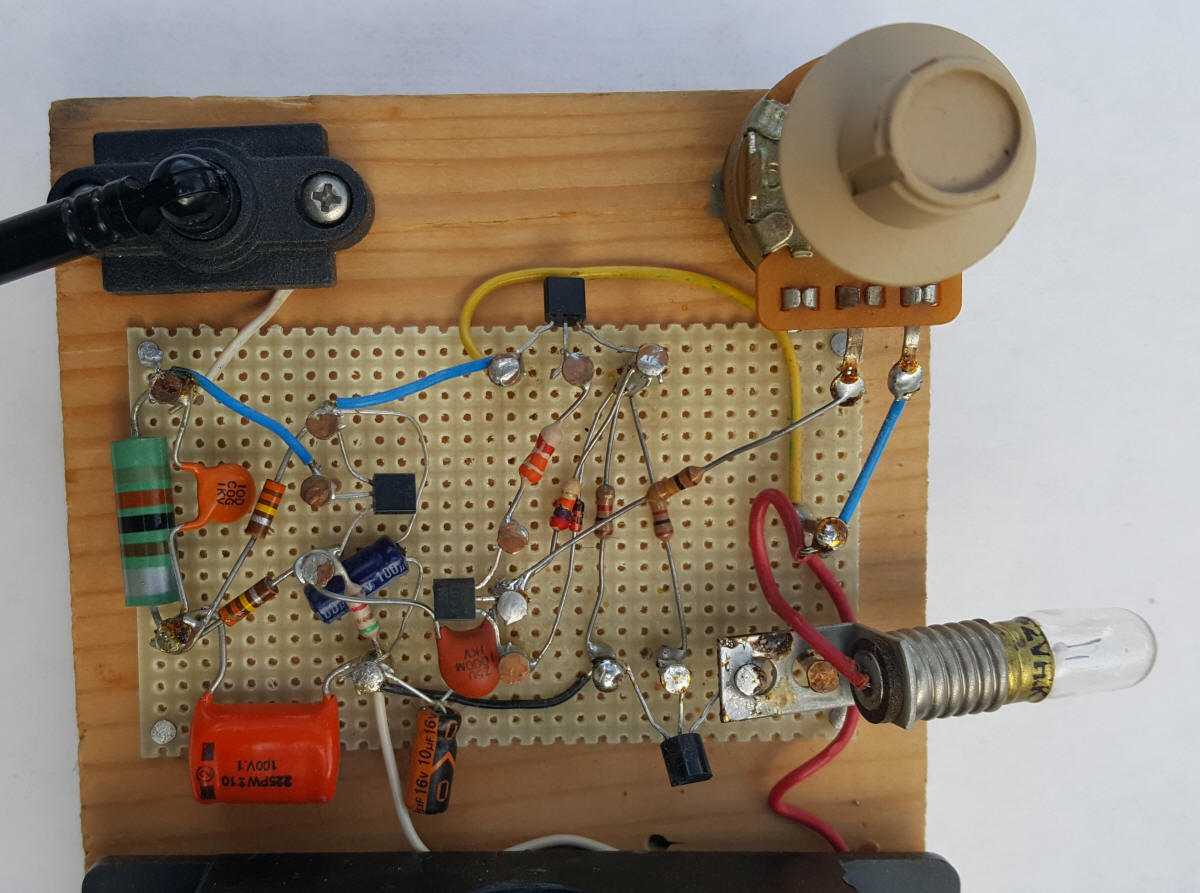
The image below is with an LED and no pot (but with the 150k
resistor added). I made several image edits for clarity and to correct
mistakes; they’re not perfect but I think the connections are clear. Ignore the
diode to the left of the 27k resistor; it has been removed from the schematic.
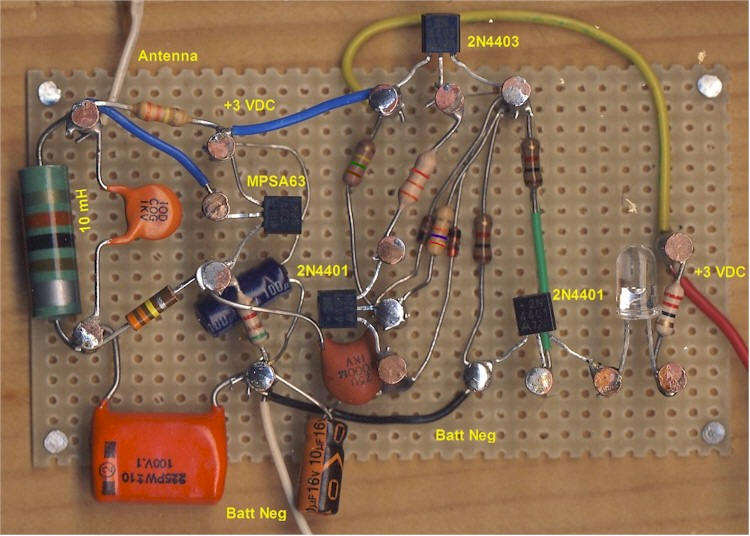
Marcos in Brazil made a video of
his detector.
![]()
Here’s a version I built into a “fake” book I found at an art
store. The copper PCB is connected to the circuit ground to act as a
counterpoise for the antenna, increasing sensitivity. The lightning bolt was cut
with a sharp knife then filled with blue-dyed epoxy. The antenna connects to the
pin jack. I used a cheap flashlight head for the LED – I used too much blue dye
in the epoxy so I need a bright flash!
![]()
Magnetic Antenna
Version
Note: The magnetic versions are more
sensitive to distant lightning but they are fairly dead to piezo lighter
impulses – those lighters don’t emit much energy at 5 kHz the way a lightning
bolt does. Same goes for my “lightning simulator.” On the other hand,
the magnetic field emanating from the speaker of a small transistor radio will
do the trick! Just tune in a station and hold the speaker near the end of the
coil.
With minor modifications it’s possible to replace the
telescoping antenna with a solenoid type inductor. One could use a ferrite loopstick operating at radio frequency but I’ve decided to tune this antenna to
about 5 kHz. The resonant tank rolls off high-frequency noise and the circuit
rejects lower frequency line-related hum. The lightning impulses ring this tank like a bell,
easily seen on the collector of the darlington with an oscilloscope.
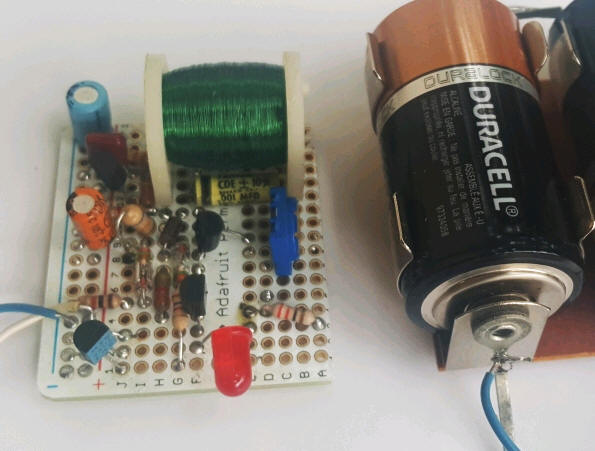
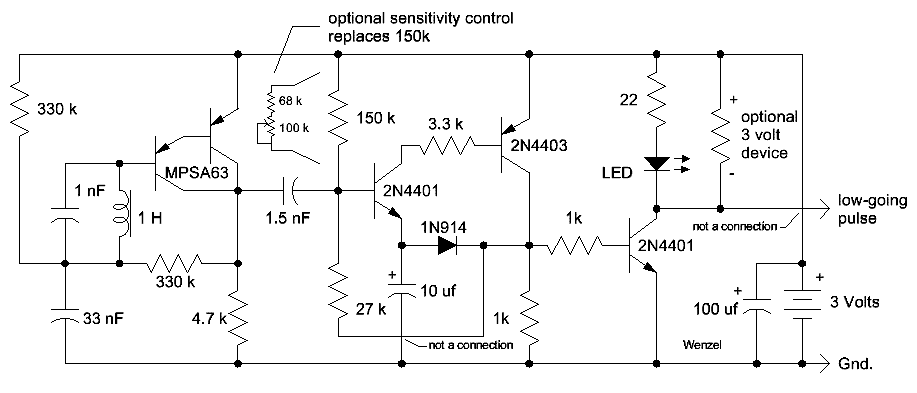
The 1 Henry inductor and 1 nF capacitor resonate near 5 kHz. Choose a value of capacitor that resonated your inductor around 5 kHz
(not particularly critical). The inductor needs to be a straight solenoid type
with no magnetic shielding on the ends. My prototype’s inductor is from the
high-voltage generator in an old CDV-715 radiation survey meter. The inductance
should be between about 50 mH and 1 H. Typical inductors are shown below:
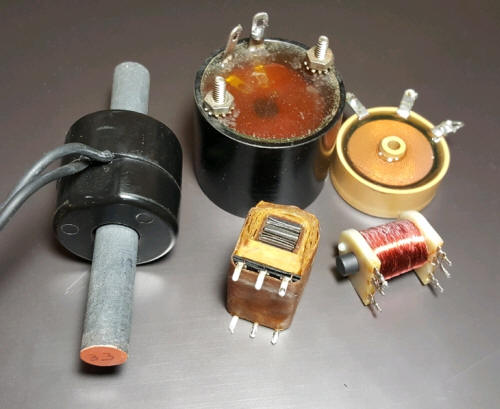
Bobbins from power transformers may also work but the core must
be removed and optionally replaced by a ferrite rod or audio transformer
laminated iron (only a straight “solenoid” core so that the external field gets
in). The black coil above is from an industrial solenoid and the large #33 Amadon core brings the inductance up to nearly 1 Henry. I’m using the tiny one
on the bottom right with good results. The pretty beige coil (an eBay find)
measures about 50 mH. Use a good quality film or NPO ceramic capacitor to
resonate your inductor. You can’t use toroids, pot cores, or other cores that
close the magnetic path back around the coil. You can probably use a relay coil
if you remove all the metal pieces. Hook your prospective coil to a high-gain
audio amplifier and if you hear distant lightning crackles you probably have a
good candidate (assuming a storm is within a hundred miles or so). When indoors
loud AC hum is another indication that the coil might be suitable.
Hook the inductor and capacitor in parallel across your scope
and apply a signal through a 1 megohm resistor with an audio generator to see
the resonance. Or use the lightning simulator and observe the frequency of the
ringing on the collector of the darlington (practical with a digital
oscilloscope). I just looked at the ringing caused
by nearby lightning.
![]()
Compound Transistor Circuit
Here’s another version that replaces the darlington transistor with a compound
transistor consisting of a PNP and NPN transistor. This change allows the use of
the venerable CA3096 transistor array. (Ordinary small-signal transistors may
also be used. ) The 10 mH resonates with about 250 pF around 100kHz, a quiet
frequency now that Loran-C is gone:

Since the
CA3096 is pretty ancient I decided to use “period” parts for the rest of the
components:
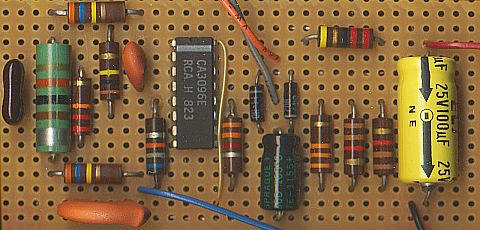
I then decided it needed to flash an old “Mazda” (GE trade
name) 3 volt light bulb but the transistor in the array can’t handle the
current. I added an old green (PNP) GE power transistor to handle the additional
current. Good design practice would suggest adding a 1k pull-up resistor at pin
9 or the power transistor base to plus but it’s really optional and it didn’t
fit nicely. Some of the resistor values differ from the schematic but most
aren’t critical.
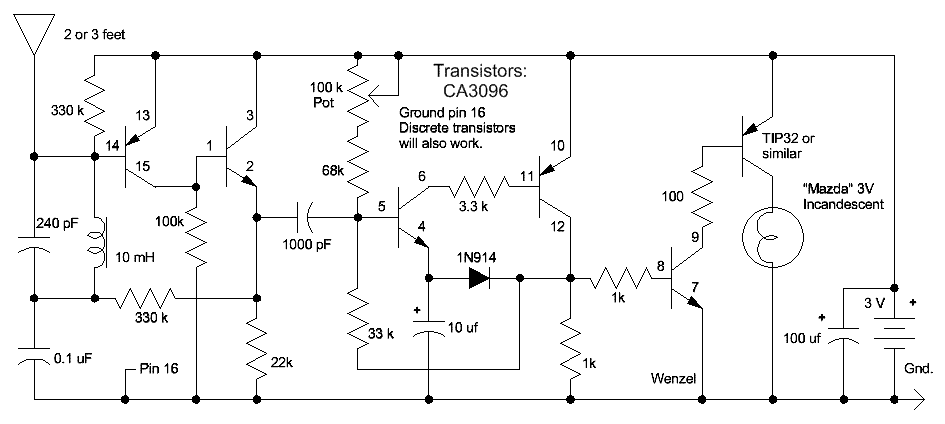
I borrowed Lennie’s jar packaging approach so that the old
components would be visible (otherwise, what’s the point? : )

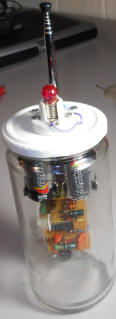
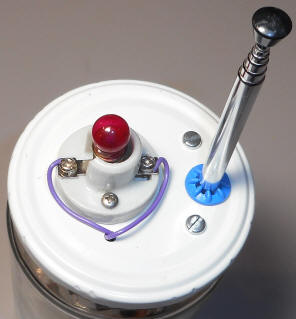

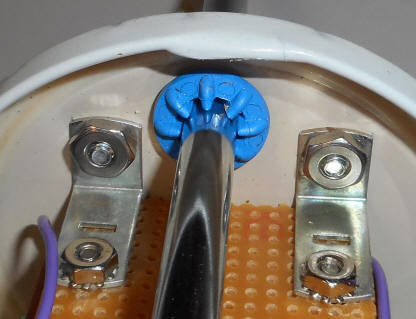
I placed that batteries near the top and secured one end of
the battery holder directly to the lid for strength.
![]()
Op-Amp Version
Don’t build this one! Unless you
just like experimenting. The idea is to rectify more of the
pulse, making the light flash longer for larger bolts (more “area under the
curve”). It works great in my old house, except when my coffee maker is running.
But too many appliances and other sources in many houses (like my new one)
produce competitive signals that will cause the thing to light up all the time
unless the sensitivity is set too low. It’s better to detect the quick lightning
impulses that stick up out of that low frequency din. I’m working on yet another
detector that will operate just below the BCB (where appliance makers are forced
to keep the noise under control to avoid BCB interference). It will probably be
nothing more than the earlier versions tuned higher in frequency, possibly with
a 455 kHz IF transformer.
Here’s a schematic using a typical “micro-power” op-amp. Choose
an op-amp with just a few 10’s of microamperes supply current to preserve
battery life.
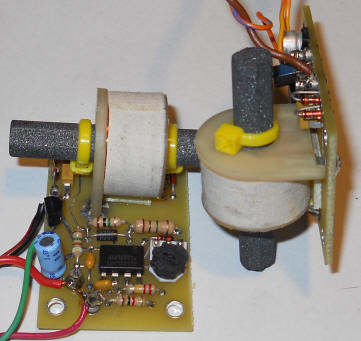
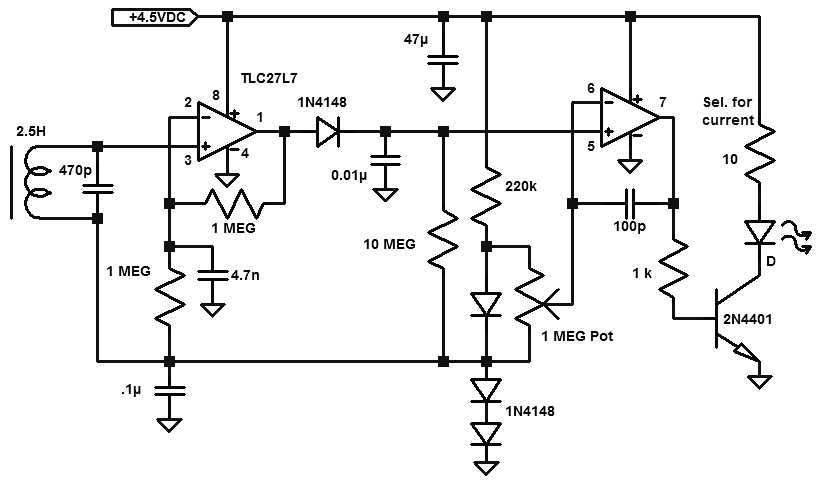
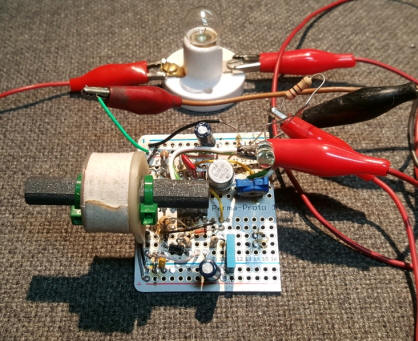
The coil and ferrite rod are from two eBay finds and measure 2.5 Henry
shunted by 90 pF. I believe the coil is for pinball machine solenoids! Adding the
470 pF brings the resonant frequency down to 5 kHz,
a great frequency for lightning energy but also just about as fast as this
op-amp can go. The first op-amp is running “open-loop” since the gain-bandwidth and output slew rate can
only support a gain of about 20 to 30 at 5 kHz. If you choose a much faster
op-amp, add a resistor (around 22k) in series with the 4.7 nF and increase that
capacitor to 0.1uF so that the gain is set by the resistor ratios. This micropower op-amp
is slow but it draws only about 20 uA so the circuit can run on 3
C-cell batteries for quite a long time – except – it’s so sensitive that it
flashes quite often. I’d turn down the sensitivity, frankly. Right now it’s
flashing in response to a storm in Louisiana and I’m in Austin, Texas. That’s
just too much sensitivity. This prototype draws 24 uA when not flashing.
Or run it on a power adapter, preferably linear to avoid
possible interference from a switching regulator. Add a 5 volt linear regulator
(LM7805) if necessary. I prefer the power hungry
incandescent bulb; they just look better in this application, at least to me.
The bottom two diodes provide a little positive voltage to bias the op-amps even
though these particular ones can look below ground a little. I was a little
worried about large signals exceeding the negative voltage input rating and I
want plenty of swing to turn on the detector diode. It’s tempting to use a
micro-power voltage reference there. The top diode in the string generates a
threshold voltage for the second op-amp that acts like a comparator. The
horizontal diode rectifies the 5 kHz ringing signal from the tuned circuit and
the .01u and 10 megohm stretch the detected pulse for a bright flash. The
time-constant is plenty short to see lots of quick flashes in succession. Strong
pulses light the lamp for longer. When using an LED the time-constant could be
shortened by reducing the .01 uF capacitor.
I stuck it in a peanut butter jar. A large standoff holds three
D-cells taped together at the bottom of the jar and the circuitry is in the lid.
The lamp screws into a Leviton socket so I can unscrew the bulb to save the
battery during busy storms. One could replace the 2N2219 with a VMOS transistor
(with very low turn-on voltage) and unscrewing the lamp would result in
extremely low current even during a busy storm since there would be no base
current (about 3 mA) during flashes. Even so, these batteries will last for years in my experience
so I just soldered them in series, no battery holder and no power switch. It immediately started flashing and, sure
enough, a storm is approaching from the northwest.
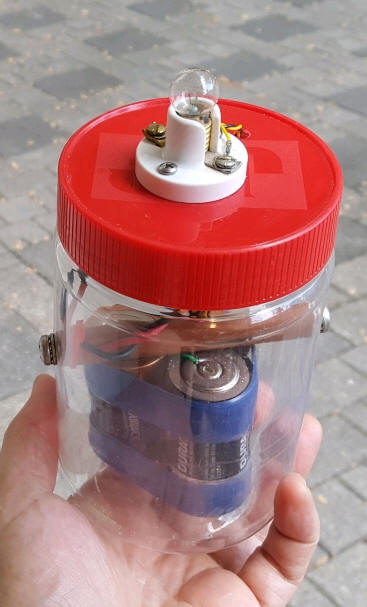
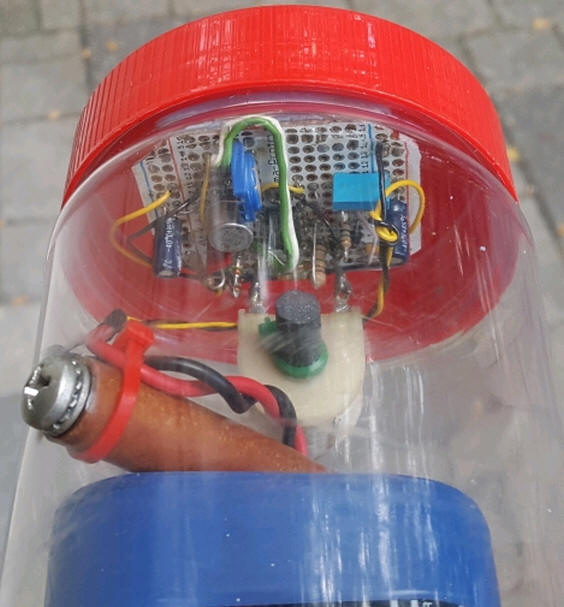
Here’s another application for this op-amp version:

That’s a large LED lightning bolt lamp I found on Amazon. (Watch
out; there’s a smaller, identical-looking bolt (just a few inches tall) but I
highly recommend the larger one that’s about 30cm.) I
removed the battery holder and added a 6.8 ohm resistor to limit the current (it
seems to like around 300 mA). It’s on a wall in my basement lab and I have to
say it’s pretty spectacular when a storm comes. The bolts cost about $16 IIRC.
I’m regulating the 5 volts to this version with a linear 3-terminal regulator
powered by 12 VDC from my security camera power supply.
By the way, don’t plug this bolt into your modern USB port on your
computer. I’m convinced the wiring is incorrect with the USB 5 volt line
connecting directly to the LEDs (and not through the 10 ohm resistor in the
battery compartment). A higher-current USB output can therefore force too much
current through the LEDs destroying the bolt quickly. Hopefully the manufacturer
will discover the error. Note the reviews by unsatisfied customers due to
premature burn-out. Older USB ports will current-limit around 500 mA but that’s
a bit high, too.


